Barley is a nutrient-dense whole grain that supports heart, gut, and metabolic health.
Rich in fiber, vitamins, and minerals, barley has been consumed for thousands of years and remains one of the most research-supported grains for promoting overall wellness. Understanding its health benefits helps you make smarter dietary choices that support digestion, cholesterol balance, and long-term vitality.
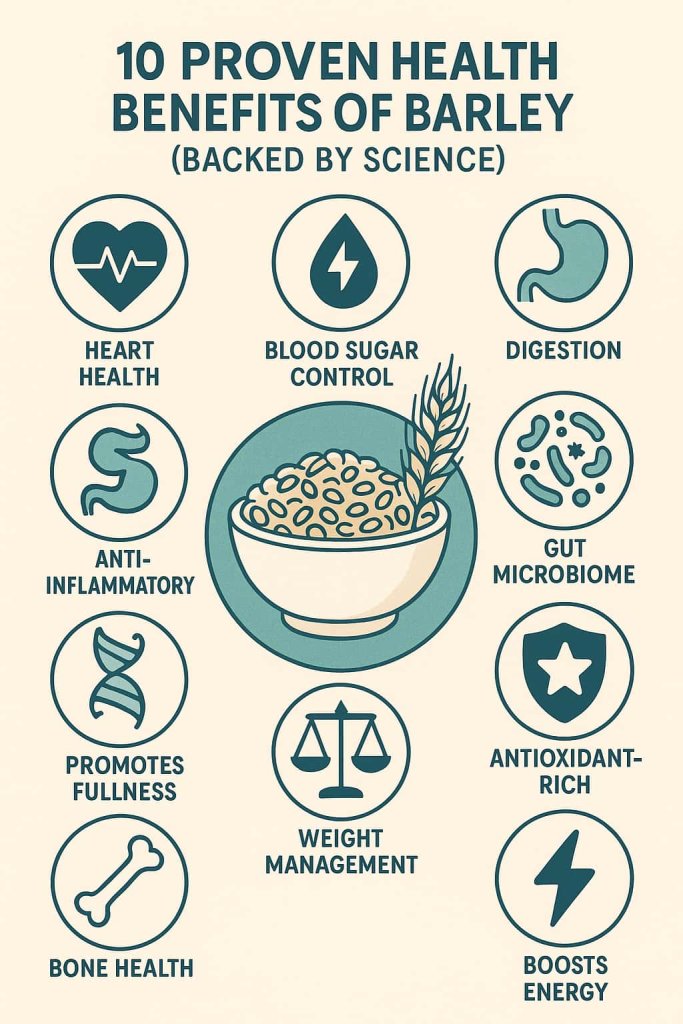
Barley can be enjoyed in soups, salads, breakfast bowls, or as a wholesome rice alternative. Below are ten evidence-based health benefits of barley, supported by recent scientific findings and expert sources.
What Is Barley? (Overview and Nutrition Profile)
Barley (Hordeum vulgare) is a nutrient-dense whole grain known for its chewy texture, mild flavor, and exceptional fiber content.
It’s one of the world’s oldest cultivated grains—grown for over 10,000 years—and remains a key ingredient in soups, stews, and whole-grain salads. Today, barley is recognized by nutrition experts and public-health authorities for its contributions to heart, gut, and metabolic health when consumed as part of a balanced diet.
Barley belongs to the Poaceae (grass) family, the same group as wheat, oats, and rye. The edible part of the plant is the barley kernel, which retains most of its nutrients when the outer bran layer and germ are preserved. Hulled barley (whole grain) retains the bran and endosperm, while pearled barley is more processed and has some fiber removed but still provides valuable nutrients.
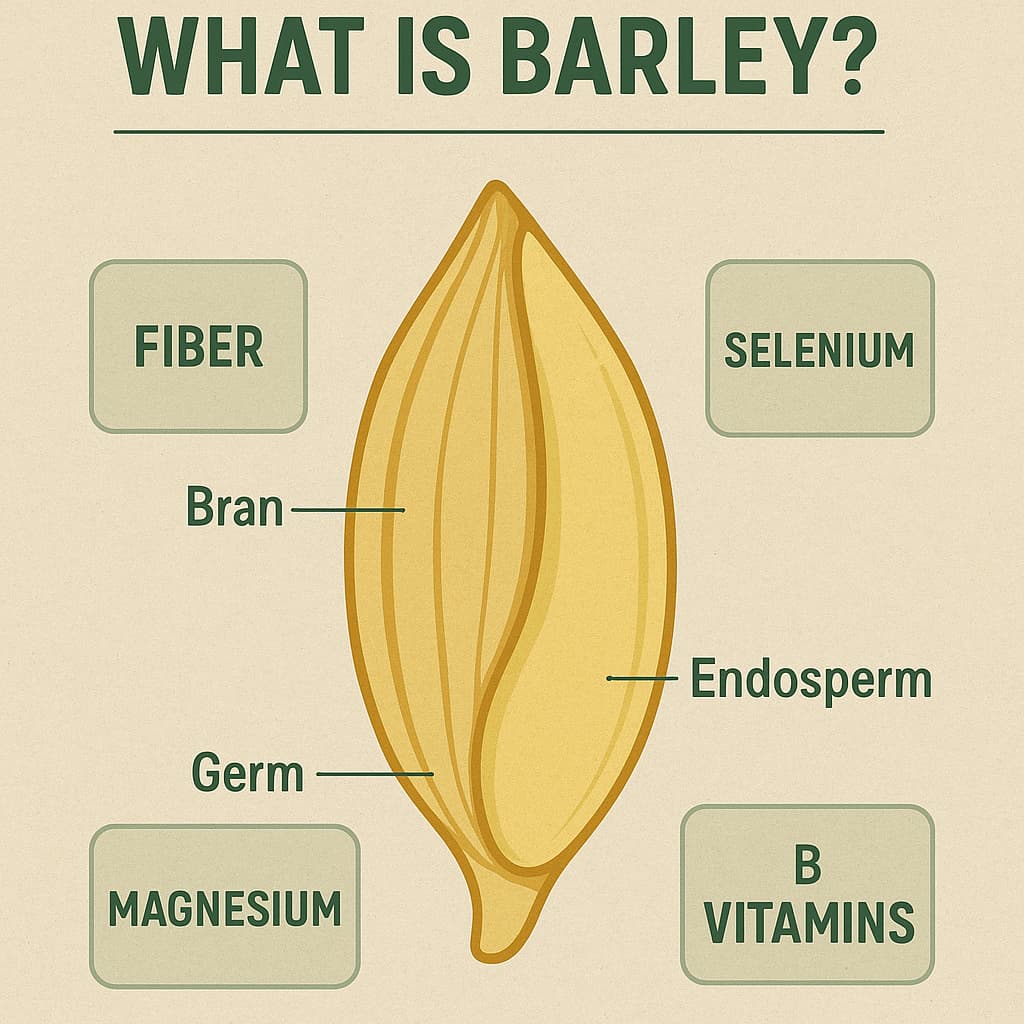
According to the U.S. Department of Agriculture (USDA) FoodData Central (2024), one cup (157 g) of cooked barley provides an impressive nutrient profile:
| Nutrient | Amount (per 1 cup cooked) | % Daily Value* |
|---|---|---|
| Calories | 193 kcal | — |
| Total Carbohydrate | 44 g | 16% |
| Dietary Fiber | 6 g | 21% |
| Protein | 3.5 g | 7% |
| Fat | 0.7 g | 1% |
| Manganese | 0.4 mg | 18% |
| Selenium | 23 µg | 42% |
| Magnesium | 80 mg | 19% |
| Phosphorus | 150 mg | 12% |
| Vitamin B6 (Pyridoxine) | 0.3 mg | 15% |
| Folate | 25 µg | 6% |
*Percent Daily Values are based on a 2,000-calorie diet.
Barley is particularly rich in β-glucan, a soluble fiber known for supporting healthy cholesterol and blood-sugar levels. It also supplies complex carbohydrates for steady energy release and a broad range of antioxidants, lignans, and phenolic compounds that contribute to cellular health.
Because barley is minimally processed and high in fiber, it digests slowly, helping maintain satiety and stable energy levels throughout the day—key factors for metabolic wellness.
10 Proven Health Benefits of Barley (Backed by Science)
Barley is one of the oldest cultivated grains, valued for its rich nutrient content and health-promoting properties. Modern research confirms that whole barley supports multiple aspects of wellness — from heart and gut health to long-term metabolic balance.
1. Supports Heart Health

Barley’s soluble fiber, β-glucan, plays a powerful role in supporting cardiovascular health. This fiber forms a gel-like substance in the digestive tract that binds cholesterol-rich bile acids and helps the body excrete them, leading to reduced LDL (“bad”) cholesterol levels.
According to Harvard T.H. Chan School of Public Health, regular consumption of whole-grain barley is associated with improved lipid profiles and a lower risk of coronary heart disease.
A meta-analysis published in the European Journal of Clinical Nutrition also found that barley β-glucan significantly reduces total and LDL cholesterol levels.
Tip: Aim for at least 3 grams of β-glucan per day from barley or oats to support healthy cholesterol levels.
2. Helps Maintain Healthy Blood Sugar Levels
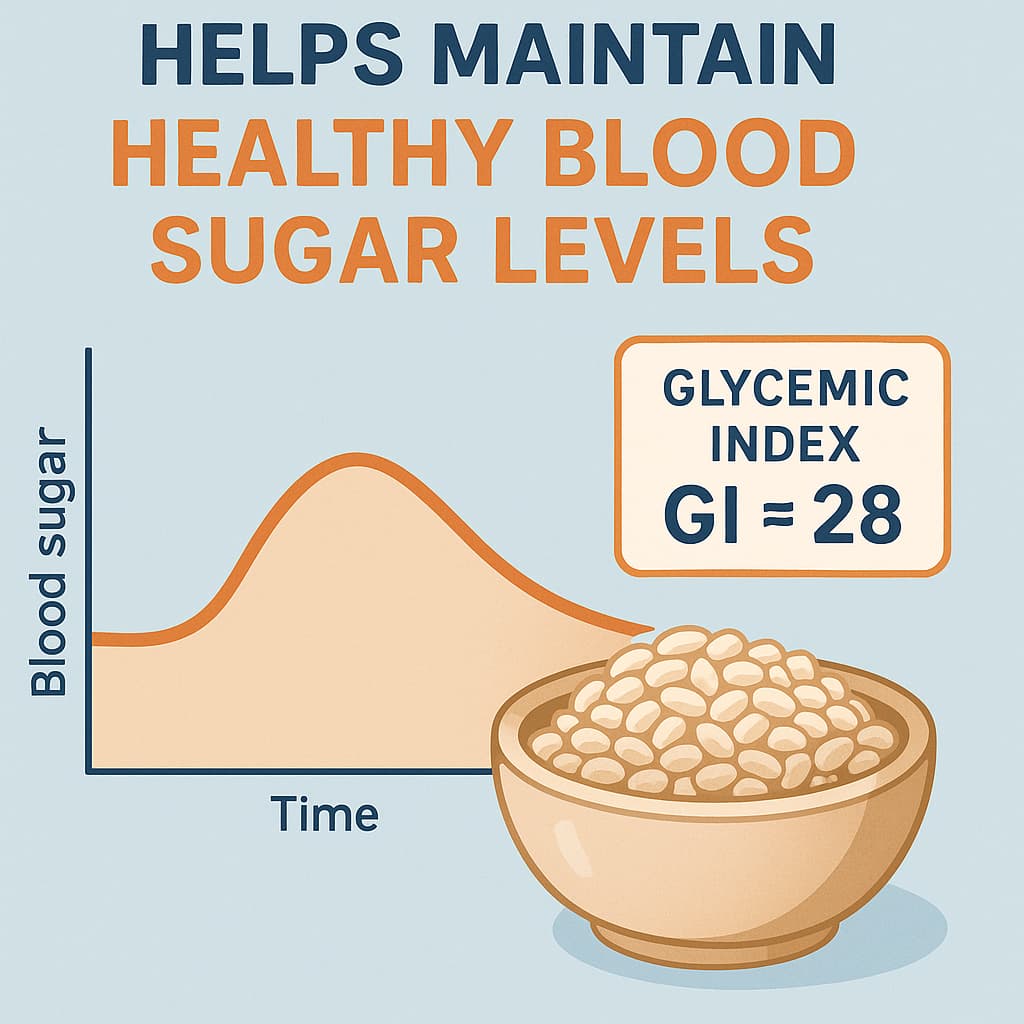
Barley may help support blood sugar control by slowing glucose absorption and improving insulin sensitivity.
A 2023 study published in Frontiers in Nutrition found that barley β-glucan lowers postprandial (after-meal) blood glucose and insulin responses, making it beneficial for people managing or at risk of type 2 diabetes.
The National Institutes of Health (NIH) supports these findings, noting that barley’s soluble fiber delays digestion and moderates carbohydrate metabolism.
Pro Tip: Choose hulled or whole-grain barley instead of pearled varieties for higher fiber and nutrient retention.
3. Promotes Digestive Health

Barley provides both soluble and insoluble fiber, which promote regular bowel movements and help maintain a balanced gut microbiome.
The prebiotic fibers in barley feed beneficial gut bacteria such as Bifidobacterium and Lactobacillus, enhancing digestive efficiency and immune health.
According to Healthline, one cup of cooked barley provides about 6 grams of fiber — roughly 20% of the daily recommended intake — which may help prevent constipation and support gut integrity.
Example: Adding barley to soups or grain salads can naturally increase your daily fiber intake.
4. May Support Weight Management

Barley is low on the glycemic index (GI ≈ 28–30) and high in fiber, helping you stay fuller for longer.
Research published in the Journal of Nutrition & Metabolism (2023) indicates that meals containing barley lead to prolonged satiety and reduced calorie consumption later in the day.
Replacing refined grains with barley may help maintain a healthy weight and reduce overeating tendencies.
Tip: Include barley in soups, grain bowls, or side dishes for a satisfying and nutrient-rich option.
5. Supports Gut Microbiome Diversity

Barley’s β-glucan and arabinoxylan fibers serve as prebiotics, feeding beneficial gut bacteria and promoting the production of short-chain fatty acids (SCFAs) like butyrate.
A 2024 study in Nutrients demonstrated that barley consumption increases populations of butyrate-producing microbes, which may support colon health and reduce intestinal inflammation.
Maintaining microbial diversity is crucial for immune balance, digestion, and overall metabolic wellness.
6. Rich in Essential Vitamins and Minerals
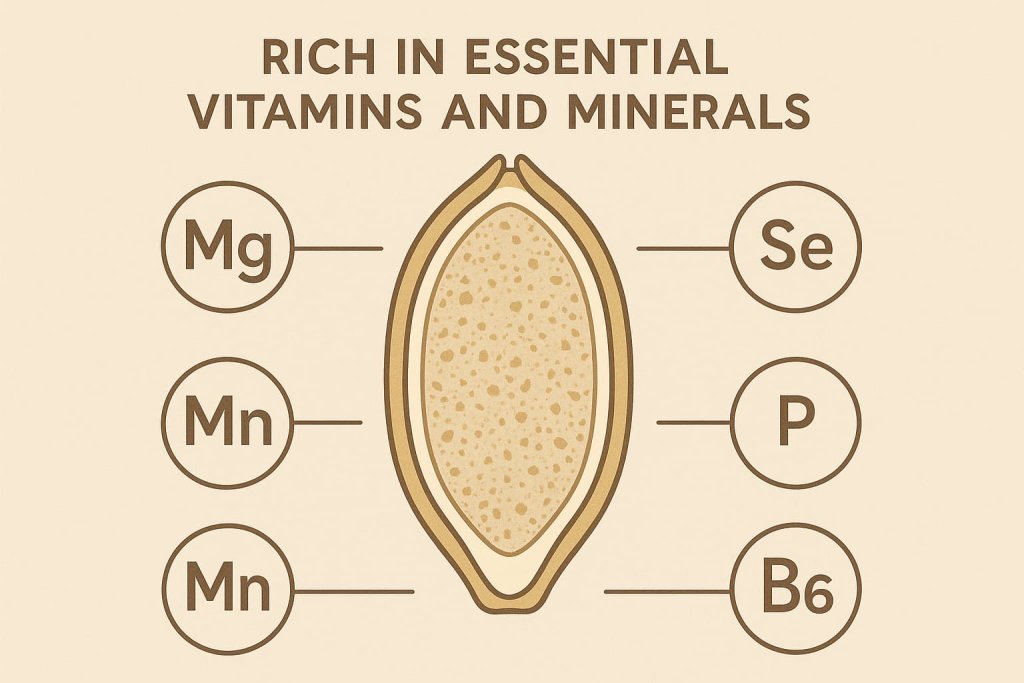
Barley is naturally rich in manganese, selenium, magnesium, phosphorus, niacin (B3), and vitamin B6, which play vital roles in metabolism and antioxidant defense.
According to USDA FoodData Central (2024), one cup (157 g) of cooked barley provides:
| Nutrient | Amount | % Daily Value* |
|---|---|---|
| Calories | 193 | — |
| Dietary Fiber | 6 g | 21% |
| Manganese | 0.4 mg | 18% |
| Selenium | 23 µg | 42% |
| Magnesium | 80 mg | 19% |
| Phosphorus | 150 mg | 12% |
| Vitamin B6 | 0.3 mg | 15% |
*Based on a 2,000-calorie diet (USDA, 2024).
These nutrients collectively support energy metabolism, nerve transmission, and antioxidant enzyme activity, reinforcing barley’s role as a whole-grain powerhouse.
7. Provides Antioxidant Protection
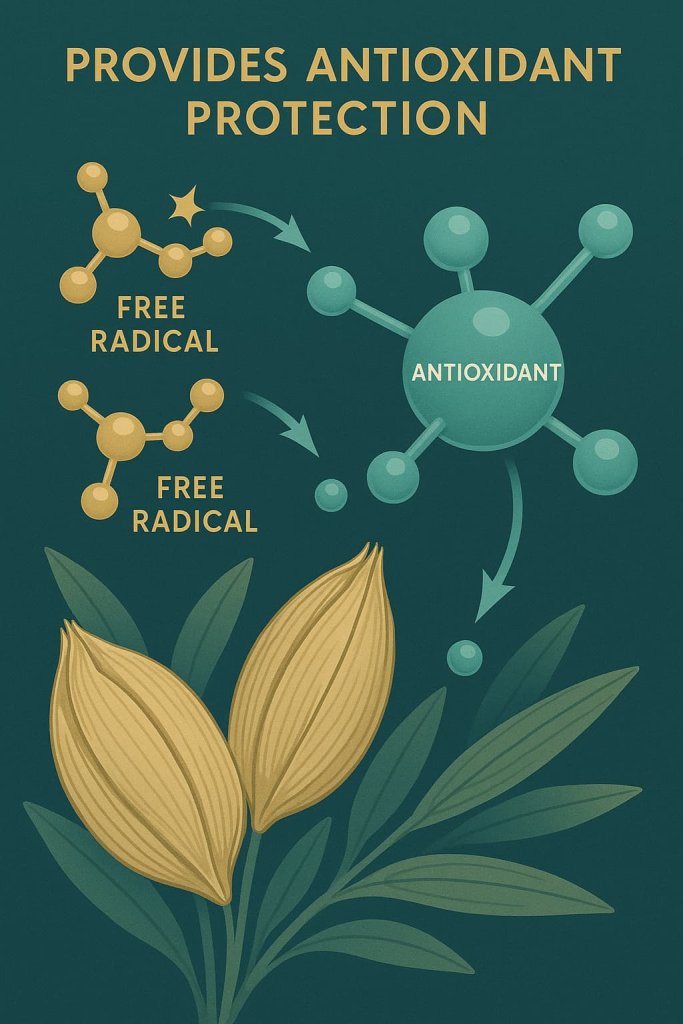
Barley contains several antioxidants, including tocopherols, phenolic acids, and lignans, that may help protect body cells from oxidative stress.
The Cleveland Clinic highlights barley as a source of plant compounds that combat oxidative damage and support long-term heart and brain health.
These compounds may contribute to reduced chronic inflammation and improved cellular resilience.
8. May Support Healthy Cholesterol Ratios
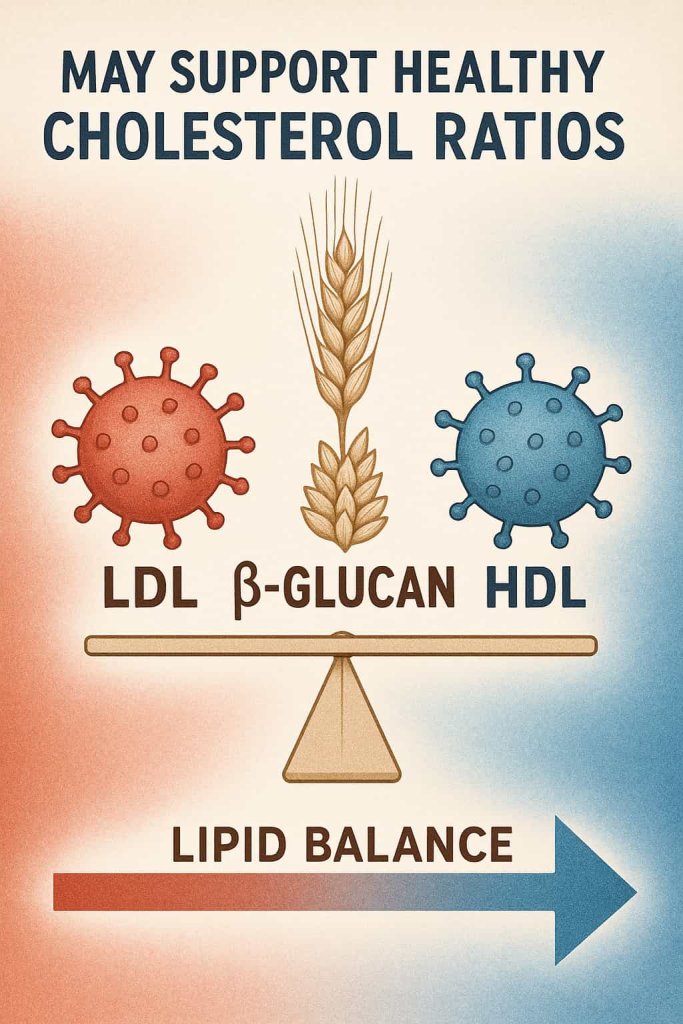
Beyond reducing LDL, barley intake may help raise HDL (“good”) cholesterol, which supports arterial flexibility and vascular health.
A controlled study published in Nutrients (2022) found that daily barley consumption improved HDL functionality and particle size — both markers of better cardiovascular health.
This dual action enhances lipid balance and helps maintain a healthy heart.
9. May Aid Bone and Joint Health

Barley provides magnesium, phosphorus, and zinc, all of which play key roles in bone mineralization and connective tissue repair.
Magnesium helps regulate calcium absorption, while phosphorus contributes to skeletal strength.
According to National Institutes of Health Office of Dietary Supplements, consistent intake of these nutrients may support long-term bone density and joint function.
10. Supports Longevity and Overall Wellness

Long-term studies associate whole-grain consumption — including barley — with reduced risks of heart disease, type 2 diabetes, and all-cause mortality.
A 2024 American Journal of Clinical Nutrition meta-analysis concluded that replacing refined grains with barley and other whole grains may extend lifespan and reduce chronic disease risk.
Barley’s unique combination of fiber, antioxidants, and micronutrients supports holistic well-being and healthy aging.
How to Add Barley to Your Diet
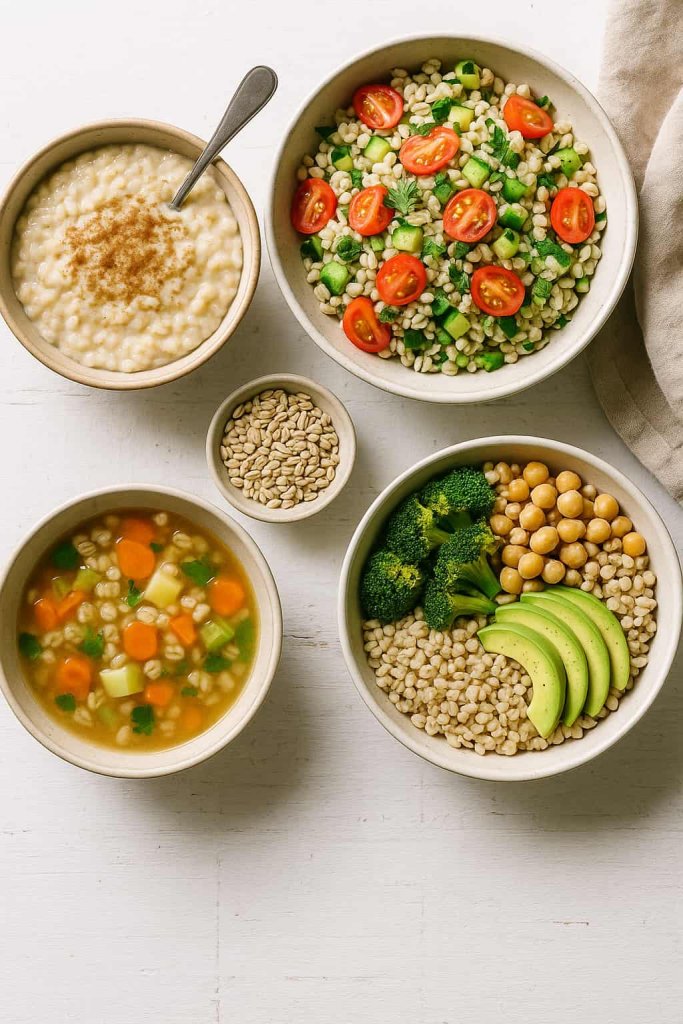
Barley is a versatile grain that fits easily into both traditional and modern meals. Its mild, nutty flavor and chewy texture make it suitable for breakfast, lunch, or dinner. Including barley in your diet can help increase your intake of fiber, vitamins, and minerals while supporting steady energy levels throughout the day.
Recommended Portion Size
A typical serving size is ½ to 1 cup of cooked barley, which provides around 3–6 grams of fiber and roughly 100–200 calories. Start with smaller portions and gradually increase your intake to allow your digestive system to adjust to the fiber content.
Cooking Methods
- Boiling: Combine 1 cup of dry hulled barley with 3 cups of water or broth. Simmer for 45–60 minutes until tender.
- Quick-Cook Method (Pearled Barley): Use 2½ cups of water for 1 cup of barley and simmer for 25–30 minutes.
- Soaking: Pre-soaking barley for several hours shortens cooking time and may enhance nutrient absorption.
For detailed cooking and soaking guidance, refer to the USDA FoodData Central preparation tips.
Easy Ways to Include Barley
- Breakfast: Replace oats with cooked barley for a hearty porridge topped with fruit, nuts, and a drizzle of honey.
- Lunch: Toss cooled barley into salads with chickpeas, spinach, and olive oil for a fiber-rich meal.
- Dinner: Use barley instead of rice in soups, stews, or grain bowls with roasted vegetables.
- Snacks: Try barley tea (mugicha) or lightly toasted barley flakes for a caffeine-free beverage rich in antioxidants.
Pro Tip: Combine barley with other whole grains such as quinoa or brown rice to diversify your nutrient intake.
Possible Side Effects and Precautions
While barley offers many health benefits, it’s important to consume it mindfully—especially if you have dietary restrictions or medical conditions.
1. Gluten Sensitivity and Celiac Disease
Barley contains gluten, a protein that can trigger immune reactions in individuals with celiac disease or non-celiac gluten sensitivity. The Celiac Disease Foundation advises avoiding barley and products derived from it (like malt or barley flour) if you follow a gluten-free diet.
2. Digestive Discomfort from High Fiber
Barley’s high fiber content may cause bloating or gas if introduced too quickly. To minimize discomfort:
- Increase intake gradually over several days.
- Drink adequate water (at least 8 glasses daily).
- Cook barley thoroughly to improve digestibility.
3. Medication Timing
High-fiber foods like barley can affect how some oral medications are absorbed by slowing or reducing their uptake.
The U.S. Food and Drug Administration (FDA) notes that meal composition, including fiber content, can influence drug absorption—especially for medications such as levothyroxine and digoxin. Studies (Scielo, 2010) show high-fiber diets may lower these drugs’ effectiveness.
4. Allergic Reactions (Rare)
Barley allergy is uncommon but possible. Symptoms may include itching, hives, or digestive upset. Consult a healthcare provider if you experience adverse reactions after consuming barley.
Storage and Food Safety Tips
Proper storage and handling ensure that barley retains its freshness, nutrients, and safety.
- Dry Barley: Store in airtight containers in a cool, dry place below 77 °F (25 °C). Keep away from moisture and direct sunlight.
- Cooked Barley: Refrigerate promptly at 40 °F (4 °C) and consume within 3–4 days.
- Freezing: Freeze cooked barley in airtight, freezer-safe containers for up to 3 months.
- Avoid Cross-Contamination: Keep barley separate from raw meat, poultry, and seafood during preparation.
For more information, visit the U.S. Department of Agriculture (USDA) Food Safety and Inspection Service – Safe Food Handling and Preparation page.
Frequently Asked Questions (FAQ)
1. Is barley healthier than rice?
Yes. Whole barley has more fiber, magnesium, and selenium than white rice, making it more beneficial for blood sugar and heart health.
2. Can I eat barley every day?
Yes, moderate daily consumption (½–1 cup cooked) is generally safe for most people and supports overall wellness.
3. Does barley help with weight management?
Barley’s high fiber and low glycemic index may help you feel full longer and reduce calorie intake, supporting healthy weight goals.
4. Is barley gluten-free?
No. Barley naturally contains gluten and should be avoided by those with celiac disease or gluten sensitivity.
5. What’s the difference between hulled and pearled barley?
Hulled barley retains its bran layer and is higher in fiber, while pearled barley is polished for faster cooking but has fewer nutrients.
6. Can barley water help detox the body?
Barley water supports hydration and digestion, but there’s no scientific evidence that it detoxifies the body.
7. Can diabetics eat barley safely?
Yes. Barley’s β-glucan helps moderate blood sugar levels. Always consult your healthcare provider for personalized advice.
Conclusion
Barley is a time-honored whole grain that offers science-backed benefits for heart health, digestion, blood-sugar balance, and overall vitality. By incorporating it into daily meals—while respecting dietary needs and safe handling practices—you can enjoy its nutritional power as part of a balanced, whole-food diet.
This content is for informational purposes only and not medical advice.
